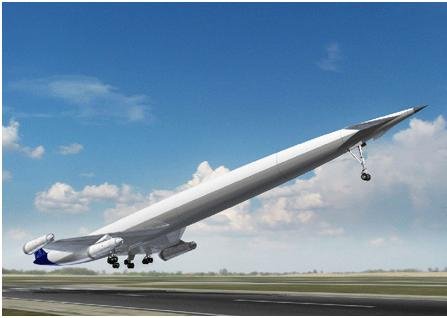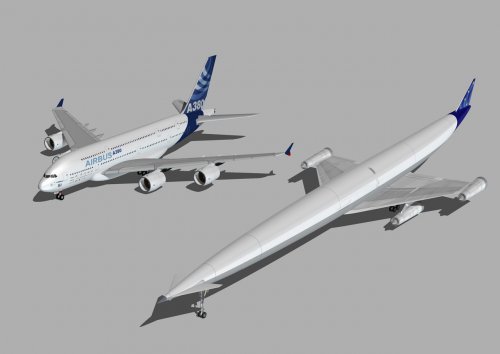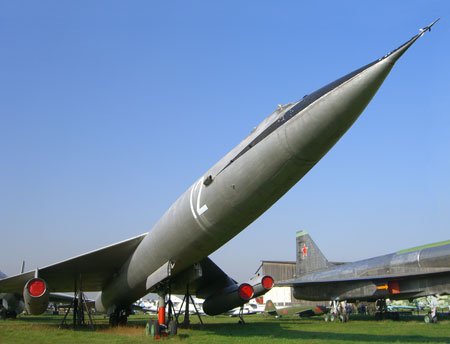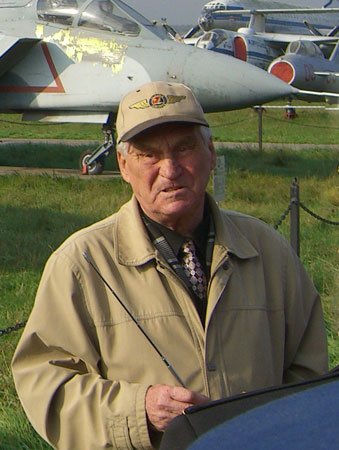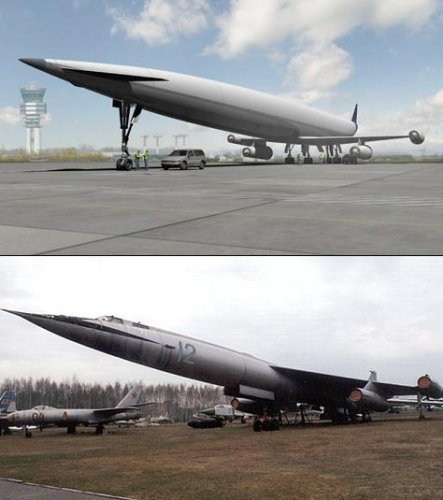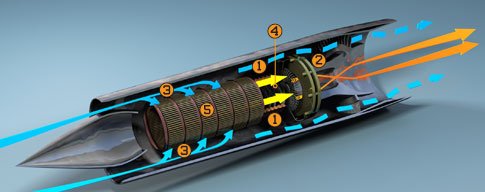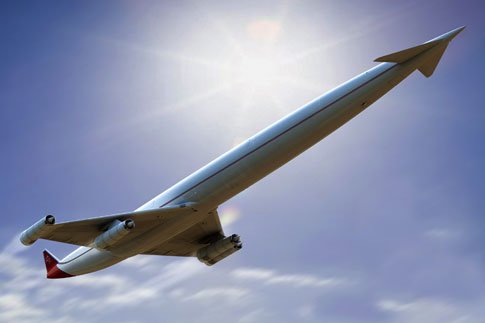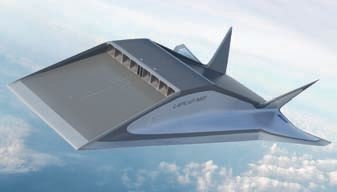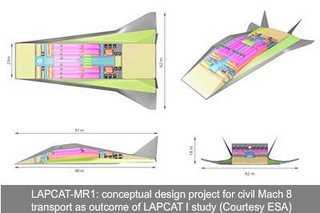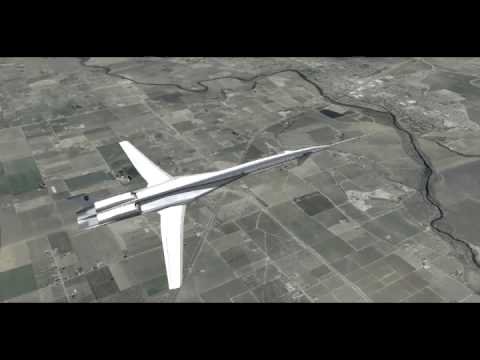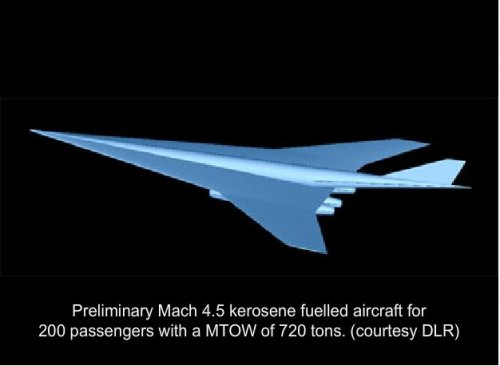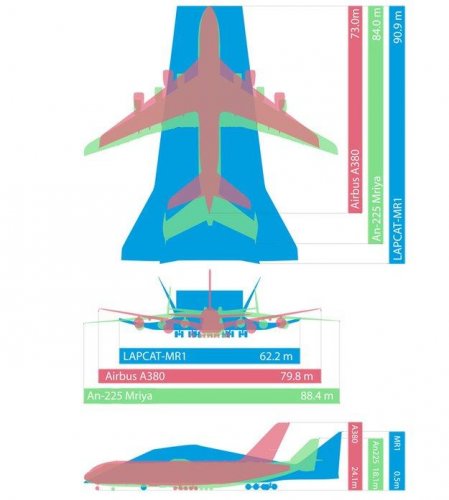You are using an out of date browser. It may not display this or other websites correctly.
You should upgrade or use an alternative browser.
You should upgrade or use an alternative browser.
EU LAPCAT (Long-Term Advanced Propulsion Concepts and Technologies) program
- Thread starter PMN1
- Start date
- Joined
- 26 May 2006
- Messages
- 34,911
- Reaction score
- 15,787
Hi,
the Reaction Engines company design of the LAPCAT/ Configuration A2 hypersonic aircraft which could carry 300 passengers.
http://www.reactionengines.co.uk/lapcat.html
http://www.flightglobal.com/articles/2008/02/05/221310/pictures-ultra-long-haul-flights-in-hypersonic-aircraft-to-take-under-five-hours.html
the Reaction Engines company design of the LAPCAT/ Configuration A2 hypersonic aircraft which could carry 300 passengers.
http://www.reactionengines.co.uk/lapcat.html
http://www.flightglobal.com/articles/2008/02/05/221310/pictures-ultra-long-haul-flights-in-hypersonic-aircraft-to-take-under-five-hours.html
Attachments
- Joined
- 1 April 2006
- Messages
- 11,397
- Reaction score
- 10,309
I think that everyone who attempt to steal Bounder wings from Monino will be sliced over the ground after attempt to remove ground supports that hold 'em in place in fact. If he will survive, that dude will finish the job)
Attachments
- Joined
- 17 October 2006
- Messages
- 2,393
- Reaction score
- 1,197
I like the last two comparison shots. It looks a bit like a four-engined CL-400 as well. I'd hate to see #1 or #4 unstart at Mach 5: could be a little too entertaining with that eedy-beedy vertical stab.
archipeppe
ACCESS: Top Secret
- Joined
- 18 October 2007
- Messages
- 2,431
- Reaction score
- 3,152
Is nice to know that English Aerospace Industry (that so much gave in the past) is born again and is coming out with a really interesting idea, so long by the HOTOL project....
red admiral
ACCESS: Top Secret
- Joined
- 16 September 2006
- Messages
- 1,805
- Reaction score
- 2,377
What surprise me was how long its taken for the media to find out about it.
Theres a small article on the BBC site, anything else in the general media?
From what i see, its not so much a "design" as a "pretty CAD image" but i'll admit I can't make out much detail on their images. The engine seems to be a hydroden fuelled turboramjet.
I have serious concerns over the construction, CFRP base with aluminium fuel tanks, outside shell being fibre reinforced ceramic 0.5mm thick?
PMN1 said:What surprise me was how long its taken for the media to find out about it.
Yeah. This was made public several years ago. All of a sudden it's on magazine covers.
???
red admiral said:I have serious concerns over the construction...
Same here. I was especially dubious about Skylon... to me it looked like it'd snap in half on re-entry.
Neither of these designs looks like they'd well tolerate any high angle of attack flight or, worse, thrust imbalance.
- Joined
- 14 June 2006
- Messages
- 2,300
- Reaction score
- 561
Probably it's near the review for the renewal of funding by ESA...  Ok, everyone has to find out a way to make a living. Today I was in Milan Polytechnic library looking for old Journal of Aircrafts articles and I was talking with the volunteer undergraduate that minds the photocopy service (no charge for it, something works fine in Italy, after all). He was surprised for all the publicity the A2 had, since he had met the British guys a year ago on an Erasmus tour, and nothing had really changed in the configuration.
Ok, everyone has to find out a way to make a living. Today I was in Milan Polytechnic library looking for old Journal of Aircrafts articles and I was talking with the volunteer undergraduate that minds the photocopy service (no charge for it, something works fine in Italy, after all). He was surprised for all the publicity the A2 had, since he had met the British guys a year ago on an Erasmus tour, and nothing had really changed in the configuration.
- Joined
- 17 October 2006
- Messages
- 2,393
- Reaction score
- 1,197
There's some auto-response thing that kicks in when anyone says "London to Sydney in 2 hours". They have nice-looking images too.
red admiral
ACCESS: Top Secret
- Joined
- 16 September 2006
- Messages
- 1,805
- Reaction score
- 2,377
Looking into it a bit more and the temperature on the outside is about 500-600°C at Mach 5 cruise. Getting a ceramic composite to withstand this is pretty easy, most likely some metal-matrix-ceramic mix that gives a nice light weight. Not sure I'd want a bird strike with only 0.5mm thickness though. The thinness of the skin is problematic as a large amount of the heat is going to be transferred through the plate to the interior, which doesn't seem to have active cooling and the CFRP base structure melts around 200°C
Anyone any ideas on why Helium is used as a cooling agent instead of the LH?
Anyone any ideas on why Helium is used as a cooling agent instead of the LH?
amsci99 said:Pretty dumb question and pardon my ignorance, now how are the passengers going to handle the 'G' forces at hypersonic speeds?
No reason why passengers here should experience anything worse than what passengers in regular jetliners experience on takeoff... they'll just experience it longer.
From the Popular Science web site:
http://www.popsci.com/military-aviation-space/article/2008-01/green-skies-mach-5
--Michael Belfiore
http://www.popsci.com/military-aviation-space/article/2008-01/green-skies-mach-5
"Modern air travel is a marvel. It's also a source of endless delay, annoyance and planet-killing greenhouse gases. A proposed hydrogen-powered hypersonic airliner could change all that. The plane is Reaction Engines's A2 concept, a Mach-5 (3,400mph) craft for 300 passengers funded in part by the European Union's Long-Term Advanced Propulsion Concepts and Technologies project (Lapcat). Lapcat wants an airliner that can fly from Brussels to Sydney in less than four hours. If built, the A2 will do just that—without producing a trace of carbon emissions.
Engineers created the A2 with the failures of its doomed supersonic predecessor, the Concorde, very much in mind. Reaction Engines's technical director, Richard Varvill, and his colleagues believe that the Concorde was phased out because of a couple major limitations. First, it couldn't fly far enough. "The range was inadequate to do trans-Pacific routes, which is where a lot of the potential market is thought to be for a supersonic transport," Varvill explains. Second, the Concorde's engines were efficient only at its Mach-2 cruising speed, which meant that when it was poking along overland at Mach 0.9 to avoid producing sonic booms, it got horrible gas mileage. "The [A2] engine has two modes because we're very conscious of the Concorde experience," he says.
Those two modes—a combination of turbojet and ramjet propulsion systems—would both make the A2 efficient at slower speeds and give it incredible speed capabilities. (Engineers didn't include windows in the design because only space-shuttle windows, which are too heavy for use in an airliner, can withstand the heat the A2 would encounter.) In the A2's first mode, its four Scimitar engines send incoming air through bypass ducts to turbines. These turbines produce thrust much like today's conventional jet engines—by using the turbine to compress incoming air and then mixing it with fuel to achieve combustion—and that's enough to get the jet in the air and up to Mach 2.5. Once it reaches Mach 2.5, the A2 switches into its second mode and does the job it was built for. Incoming air is rerouted directly to the engine's core. Now that the plane is traveling at supersonic speed, the air gets rammed through the engine with enough pressure to sustain combustion at speeds of up to Mach 5.
That's the principle behind all ramjet designs. But the Scimitar's system goes further by adding a turbine compressor that squeezes air even more intensely. This is a big departure from traditional ramjet design; these air-breathing engines normally can't use turbines because the air enters the engine at such a high temperature—1,800ºF at Mach 5—that turbine blades would quickly melt. In the Scimitar, though, a cooling system wrapped around the inside of the engine cools incoming air enough to let it run through a turbine. As a result, the A2 has a setting for every speed.
But an even greater asset than the A2's speed is its negligible carbon footprint. It's hydrogen-powered, so it produces only water vapor and a little bit of nitrous oxide as exhaust. And although a hypersonic jet loaded with liquid hydrogen might sound dangerous, hydrogen fuel is actually no more explosive than normal jet fuel.
Joseph Schetz, a hypersonic-propulsion expert at Virginia Tech, says there's nothing fundamentally unsound in the A2's plans, "but whether it's doable or not is a whole other conversation." The engineers still face crucial design obstacles, such as building heat exchangers reliable enough for hypersonic flight.
The biggest challenge: manufacturing hydrogen fuel on a large scale without emitting carbon in the process. Indeed, Varvill is hesitant to pitch his plane as a truly green machine because he believes carbon-free hydrogen production is still a long way off. If a viable hydrogen economy comes to pass, though, the A2 could very well be the new airliner of choice."
The Scimitar Engine:
"For takeoff, landing and subsonic flight, the A2's Scimitar engine sends intake air through a bypass duct [1] and into a turbine [2], like a standard jet engine. After reaching supersonic speed, though, the engine redirects air from the bypass duct through the engine core [3] for flight up to Mach 5. Like a ramjet, the Scimitar works by taking in air from the atmosphere at high speeds and funneling (or "ramming") it until it's intensely compressed. At this point, the extremely hot air mixes with fuel and causes ignition. But the Scimitar one-ups traditional ramjet design by adding a turbine [4] that compresses the incoming air even further. Ramjets usually can't use turbines because the incoming air is so hot that it will melt the turbine blades. The Scimitar solves that problem by first cooling the air in a heat exchanger [5] using gaseous helium."
--Michael Belfiore
Attachments
A
avatar
Guest
gentlemen are the canards going to be useful for the proposed subsonic flight envelope? Is that why they are there?
Please elaborate
Please elaborate
A
avatar
Guest
Also is this design potentially capable of > mach 5 flights minus those canard extensions?
KJ_Lesnick
ACCESS: Top Secret
- Joined
- 13 February 2008
- Messages
- 1,042
- Reaction score
- 114
Honestly, I think there are many other aerodynamic shapes that would be far more effective...
I take it this plane is comparatively light for it's overall size? Because otherwise, the wing-loading is going to be outrageously high.
I take it this plane is comparatively light for it's overall size? Because otherwise, the wing-loading is going to be outrageously high.
- Joined
- 27 December 2005
- Messages
- 17,749
- Reaction score
- 26,422
Not convinced by the aerodynamics either, but then its an engine company really.
Hi everybody
Someone knows a LAPCAT Mach 8 design ? The Scramjets are on Top of the fuselage !
I saw it here
http://abenteuerwissen.zdf.de/ZDFde/inhalt/1/0,1872,1020545,00.html?dr=1
There is also the video !
Maybe someone can help with a picture ?
Many Thanks
Someone knows a LAPCAT Mach 8 design ? The Scramjets are on Top of the fuselage !
I saw it here
http://abenteuerwissen.zdf.de/ZDFde/inhalt/1/0,1872,1020545,00.html?dr=1
There is also the video !
Maybe someone can help with a picture ?
Many Thanks
KJ_Lesnick
ACCESS: Top Secret
- Joined
- 13 February 2008
- Messages
- 1,042
- Reaction score
- 114
moin1900,
Why would a person want to put the inlets on top? It would be far better to put them on the bottom and integrate the airplane into a wave-riding platform...
KJ Lesnick
Why would a person want to put the inlets on top? It would be far better to put them on the bottom and integrate the airplane into a wave-riding platform...
KJ Lesnick
- Joined
- 2 August 2006
- Messages
- 3,256
- Reaction score
- 1,528
Aerodynamically, I don't see a problem with the configuration. To really be able to criticize it, you would have to know what their design goals were that were stated in the mission profile. There are some "better" aerodynamic configurations", but it would appear to me that minimizing weight and ease of manufacturing and maintenance were big drivers as well. You aren't going to get lower cost than a simple circular cross section fuselage, which also makes minimizing weight easier. If they can minimize their interference drag at the wing/fuselage interface, I don't see any reason not to use this configuration.
Shock cone inlets are very efficient and light weight. Also, by making the engines podded, I'm sure that makes maintenance much easier. Of course, it adds surface area and , hence, drag. But it seems to me they took a very balanced approach to the problem here, instead of going all out on just optimizing the aerodynamics/propulsion interface.
As for the canards, yes they would help subsonically, since the wing and canard would be optimized for supersonic flight, the canard is there to minimize the change in trim (trim drag) due to the a.c. shift. However, you should also note that this aircraft has a relatively small delta wing located close to the c.g. and as such, you aren't going to get pitch authority from it. So you would still need a "tail" of some sort to trim/control the aircraft. As such, the best "tail" for the mission, is a canard in this case.
Shock cone inlets are very efficient and light weight. Also, by making the engines podded, I'm sure that makes maintenance much easier. Of course, it adds surface area and , hence, drag. But it seems to me they took a very balanced approach to the problem here, instead of going all out on just optimizing the aerodynamics/propulsion interface.
As for the canards, yes they would help subsonically, since the wing and canard would be optimized for supersonic flight, the canard is there to minimize the change in trim (trim drag) due to the a.c. shift. However, you should also note that this aircraft has a relatively small delta wing located close to the c.g. and as such, you aren't going to get pitch authority from it. So you would still need a "tail" of some sort to trim/control the aircraft. As such, the best "tail" for the mission, is a canard in this case.
- Joined
- 1 April 2006
- Messages
- 11,397
- Reaction score
- 10,309
The European Union’s LAPCAT (Long-Term
Advanced Propulsion Concepts and Technologies)
project aims to shorten the travel time for
intercontinental flights—for
example, reducing flight time
between Brussels and Sydney
to approximately 2-4 hr.
During Phase I, TBCC and
RBCC (rocket-based combined
cycle) engines were
evaluated at Mach 4-8. Mach
5 and Mach 8 airliners, both
hydrogen-fueled, are achievable for a long-distance
range; a hydrocarbon-fueled Mach 4.5
aircraft has a shorter range. Phase II focuses on
Reaction Engine’s Scimitar engine, to cruise at
Mach 5, and on the Mach 8 aircraft and related
propulsion unit.
MBDA France and ONERA are pursuing
Phase II of the LEA program for flight tests of a
4-m-long vehicle at Mach numbers of 4-8 with
DMR for approximately 10 sec. Each test vehicle
will use a fixed-geometry engine. A mixture
of gaseous methane and gaseous hydrogen has
been selected to increase the density of fuel and
to ensure robust ignition and good combustion
efficiency.
The MBDA/ROXEL test facility at Bourges
Subdray test center received upgrades to conduct
long-duration tests and allow tests at conditions
up to Mach 7.5. The upgraded facility is
called METHYLE. A modular water-cooled
DMR combustion chamber makes feasible propulsion
system technology tests such as for endothermic
fuel reforming, engine control systems,
measurement techniques, and fuel-cooled
structures.
Advanced Propulsion Concepts and Technologies)
project aims to shorten the travel time for
intercontinental flights—for
example, reducing flight time
between Brussels and Sydney
to approximately 2-4 hr.
During Phase I, TBCC and
RBCC (rocket-based combined
cycle) engines were
evaluated at Mach 4-8. Mach
5 and Mach 8 airliners, both
hydrogen-fueled, are achievable for a long-distance
range; a hydrocarbon-fueled Mach 4.5
aircraft has a shorter range. Phase II focuses on
Reaction Engine’s Scimitar engine, to cruise at
Mach 5, and on the Mach 8 aircraft and related
propulsion unit.
MBDA France and ONERA are pursuing
Phase II of the LEA program for flight tests of a
4-m-long vehicle at Mach numbers of 4-8 with
DMR for approximately 10 sec. Each test vehicle
will use a fixed-geometry engine. A mixture
of gaseous methane and gaseous hydrogen has
been selected to increase the density of fuel and
to ensure robust ignition and good combustion
efficiency.
The MBDA/ROXEL test facility at Bourges
Subdray test center received upgrades to conduct
long-duration tests and allow tests at conditions
up to Mach 7.5. The upgraded facility is
called METHYLE. A modular water-cooled
DMR combustion chamber makes feasible propulsion
system technology tests such as for endothermic
fuel reforming, engine control systems,
measurement techniques, and fuel-cooled
structures.
Attachments
KJ_Lesnick
ACCESS: Top Secret
- Joined
- 13 February 2008
- Messages
- 1,042
- Reaction score
- 114
Is this thing to be manned or unmanned?
I'd think either hydrogen embrittlement , the fact that hydrogen becomes a strong reducing agent at higher temperatures or a combination of both.red admiral said:Anyone any ideas on why Helium is used as a cooling agent instead of the LH?
KJ_Lesnick
ACCESS: Top Secret
- Joined
- 13 February 2008
- Messages
- 1,042
- Reaction score
- 114
600-C at Mach 5? What temperatures would you get at Mach 8?
FutureSpaceTourist
ACCESS: Top Secret
- Joined
- 10 March 2010
- Messages
- 590
- Reaction score
- 34
Reaction Engine's animation of their A2 hypersonic aircraft has been posted on youtube:
http://www.youtube.com/watch?v=yJ0ZUnJs5sg
http://www.youtube.com/watch?v=yJ0ZUnJs5sg
Three-view drawing of Reaction Engines A2
Artist's impression of Reaction Engines A2.
Sources:
http://www.reactionengines.co.uk/images_lapcat.html
Artist's impression of Reaction Engines A2.
Sources:
http://www.reactionengines.co.uk/images_lapcat.html
Attachments
-
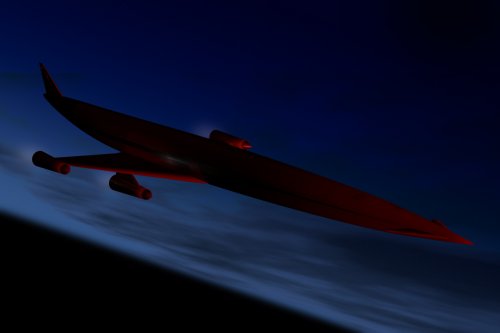 a2_heating_1280.jpg170.9 KB · Views: 31
a2_heating_1280.jpg170.9 KB · Views: 31 -
 With_A380_Front_1280.jpg22.7 KB · Views: 23
With_A380_Front_1280.jpg22.7 KB · Views: 23 -
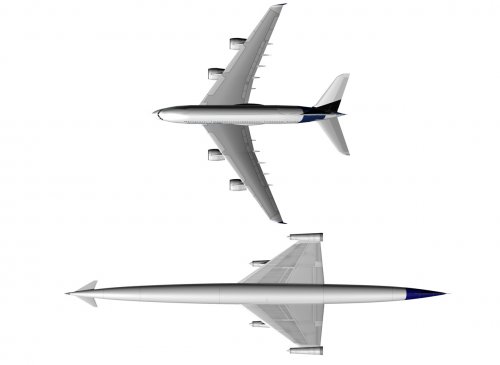 With_A380_Top_1280.jpg59.9 KB · Views: 25
With_A380_Top_1280.jpg59.9 KB · Views: 25 -
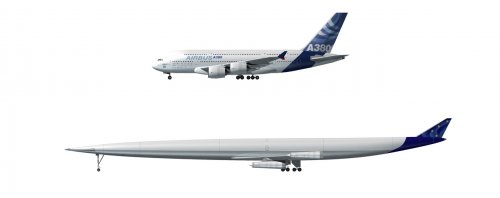 With_A380_Side_1280.jpg42.4 KB · Views: 27
With_A380_Side_1280.jpg42.4 KB · Views: 27 -
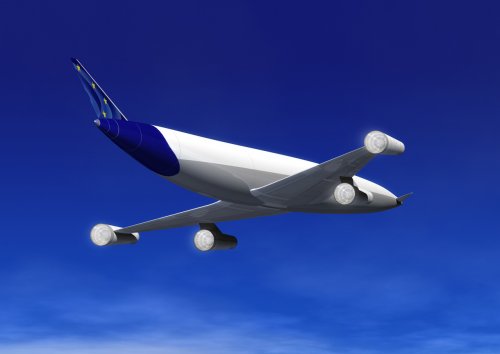 inflight_underneath_1280.jpg103.3 KB · Views: 196
inflight_underneath_1280.jpg103.3 KB · Views: 196 -
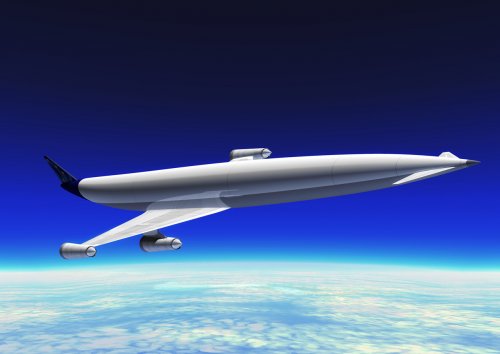 25km_up_A4_1280.jpg174.3 KB · Views: 208
25km_up_A4_1280.jpg174.3 KB · Views: 208 -
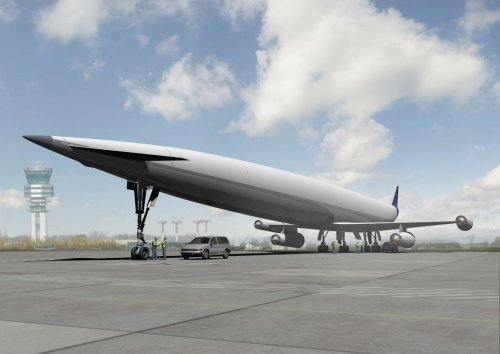 A2_2000_Ground_1280.jpg205.1 KB · Views: 231
A2_2000_Ground_1280.jpg205.1 KB · Views: 231 -
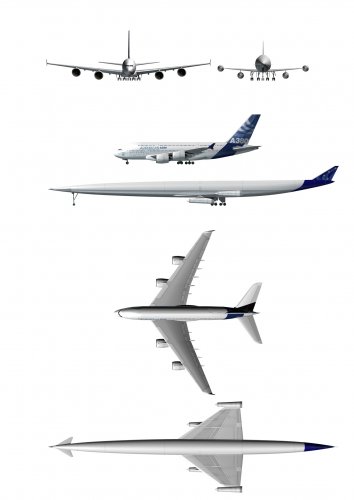 A2_A380_comparison.jpg137.3 KB · Views: 263
A2_A380_comparison.jpg137.3 KB · Views: 263
- Joined
- 26 May 2006
- Messages
- 34,911
- Reaction score
- 15,787
Attachments
- Joined
- 6 August 2007
- Messages
- 3,895
- Reaction score
- 5,982
hesham said:
Looks quite a bit like one of the Lockheed Persistor concepts
http://www.secretprojects.co.uk/forum/index.php/topic,191.msg89510.html#msg89510
There have been twin engine versions like your image.
- Joined
- 26 May 2006
- Messages
- 34,911
- Reaction score
- 15,787
Hi,
here is the LAPCAT 4.5 Mach kerosene fuelled aircraft for 200 passenger,and a comparison
between MR1 8 Mach aircraft in size with Airbus A.380 and Antonov An-225.
http://www.esa.int/Our_Activities/Space_Engineering/Achievements_obtained_within_the_European_LAPCAT_program
here is the LAPCAT 4.5 Mach kerosene fuelled aircraft for 200 passenger,and a comparison
between MR1 8 Mach aircraft in size with Airbus A.380 and Antonov An-225.
http://www.esa.int/Our_Activities/Space_Engineering/Achievements_obtained_within_the_European_LAPCAT_program
Attachments
Similar threads
-
Reaction Engines Limited Sapphire and Serpent engines
- Started by PMN1
- Replies: 0
-
Secret Projects: Military Space Technology by Bill Rose
- Started by overscan (PaulMM)
- Replies: 35
-
-
-

